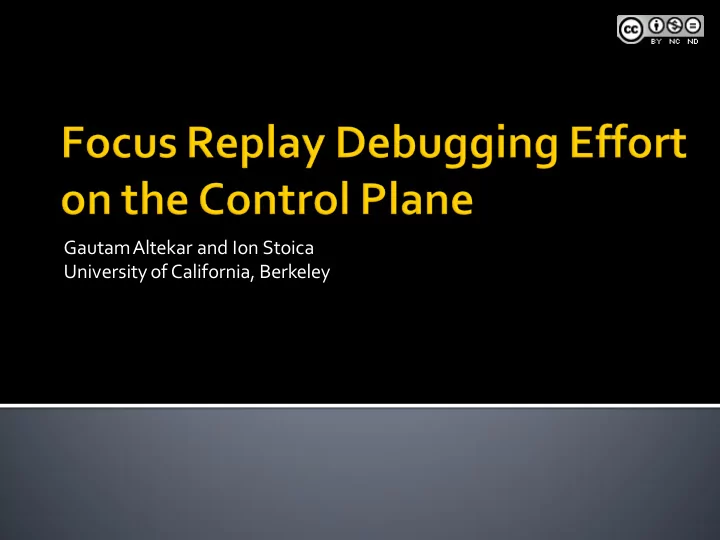

GautamAltekar and Ion Stoica University of California, Berkeley
Debugging datacenter software is really hard Datacenter software? Hard? Non-determinism Large-scale, Can’t reproduce data-intensive, failures distributed apps Can’t cyclically debug How can we reproduce non-deterministic failures in datacenter software?
Generate replica of original run, hence failures Non-deterministic data Record Log file Replay Non-deterministic data (e.g., inputs, thread interleaving) Why deterministic replay? Model checking, testing, verification Goal: find errors pre-production Can’t catch all errors Can’t reproduce production failures
Always-on production use < 5% slowdown Log no more than traditional console logs (100 Kbps) High fidelity replay Reproduce the most difficult of non-deterministic bugs
None suitable for the datacenter Always-on High fidelity operation? replay? FDR, Capo, No Yes CoreDet VMWare, Yes No PRES, ReSpec ODR, ESD, Yes No SherLog R2 Yes No
Build a Data Center Replay System Target Design for Record efficiently Large-scale, data- ~20% overhead, 100 intensive, KBps distributed apps High replay fidelity Replays difficult bugs Linux/x86
Overview Approach Testing the Hypothesis Preliminary Results Ongoing Work
For debugging , not necessary to produce identical run Often suffices to produce any run that has same control-plane behavior
Datacenter apps have two components 1. Control-plane code 2. Data-plane code Manages the data Processes the data Complicated, Low traffic Simple, High traffic Distributed data placement Checksum verification Replica consistency String matching
Relax guarantees to control-plane determinism Meet all requirements for a practical datacenter replay system
Overview Approach Testing the Hypothesis Preliminary Results Ongoing Work
Experimentally show the control plane has: 1. Higher bug rates, by far Most bugs must stem from control plane code Implies high fidelity replay 2. Lower data rates, by far Consumes and generates very little I/O Implies low overhead recording
Data Plane Control Plane 99% 1% 99% 1% Data Rate Data Rate Bug Rate Bug Rate Evidence support the hypothesis
Overview Hypothesis Testing the Hypothesis How? Preliminary Results Ongoing Work
To make statements about planes, we must first identify them Goal: Classify code as control and data plane code Hard: tied to program semantics Obvious approach: Manually identify plane code Error prone and unreliable
1. Manually identify user-data files User data? E.g., file uploaded to HDFS 2. Automatically identify static instructions tainted by user data Taint-flow analysis 3. Instructions tainted by user data are in data plane; others are in control plane
Instruction-level Works with apps written in arbitrary languages Dynamic Easier to get accurate results (e.g., in the presence of dynamically generated code) Distributed Avoids need to identify user-data entry points for each component
It’s imprecise We may have misidentified user data (unlikely) We don’t propagate taint across tainted -pointer dereferences (to avoid false positives) It’s incomplete Dynamic analysis often has low code coverage Results do not generalize to arbitrary executions
Overview Hypothesis Testing the Hypothesis Evaluation Ongoing Work
Distributed applications Hypertable: Key-value store KFS/CloudStore: Filesystem OpenSSH (scp): Secure file transfer Configuration 1 client, 1 of each system node 10 GB user-data file Kept simple to ease understanding
Bug rates Indirect: code size (static x86 instructions executed) Direct: Bug-report count (Bugzilla) Data rates Fraction of total I/O
Overview Hypothesis Testing the Hypothesis Evaluation OpenSSH Ongoing Work
OpenSSH: Executed Static Instructions Control (%) Data (%) Total (K) Agent 100 0 11 Server 97.8 2.2 103 Client (scp) 98.9 1.1 69 Average 98.9 1.1 61 Even components that touch user-data are almost exclusively control plane
OpenSSH: Bugzilla Report Count Control (%) Data (%) Total Agent 100 0 2 Server 100 0 215 Client (scp) 99 1 153 Average 99.7 0.3 123 Control plane is the most error-prone, even in components that touch user-data
(1) Control plane executes many functions to perform its core tasks OpenSSH: # of functions hosting top 90% of dynamic instructions Control Data Agent 13 0 Most active data plane functions: Server 100 1 aes_encrypt() and Client 27 1 aes_decrypt() (scp) Average 47 1
(2) Control plane relies heavily of custom code OpenSSH: % of Dynamic Instructions Issued from Libraries Control Data (%) (%) Data plane often relies Agent 82.7 0 on well-tested libraries Server 93.6 99.6 (e.g., libc, libcrypto, etc.) Client 96.2 100 (scp) Average 90.8 99.8
What should I say here? Control (%) Data (%) Total (GB) Agent 100 0 0.001 Server 0.8 99.2 20.2 Client (scp) 0.6 99.4 20.2
How well do results generalize? To other code paths To other applications How do we achieve control plane determinism? Should we just ignore the data plane? Should we use inference techniques?
What have we argued? Control-plane determinism enables record- efficient, high-fidelity datacenter replay What’s next? More application data points Questions?
Recommend
More recommend